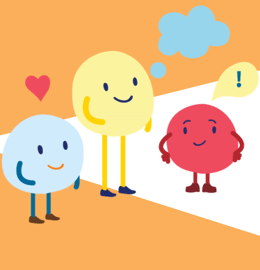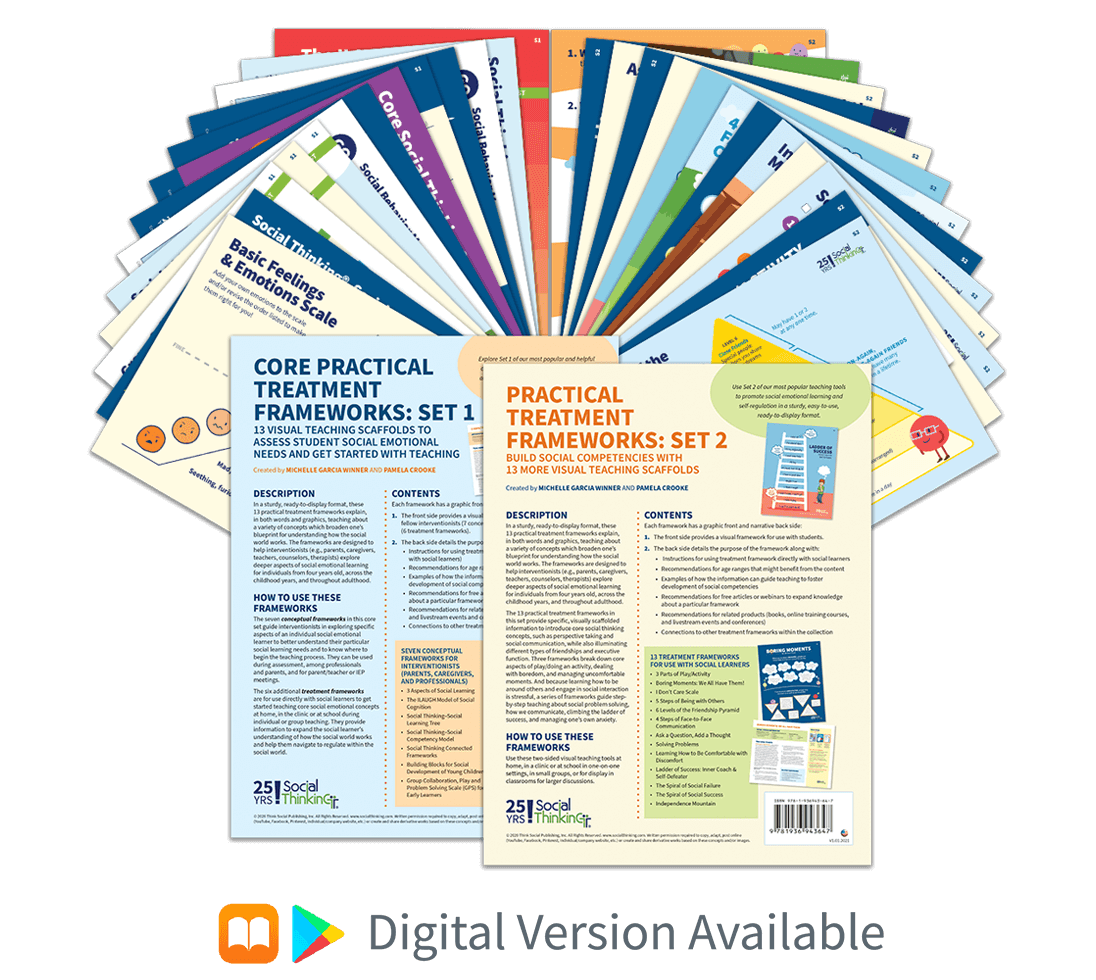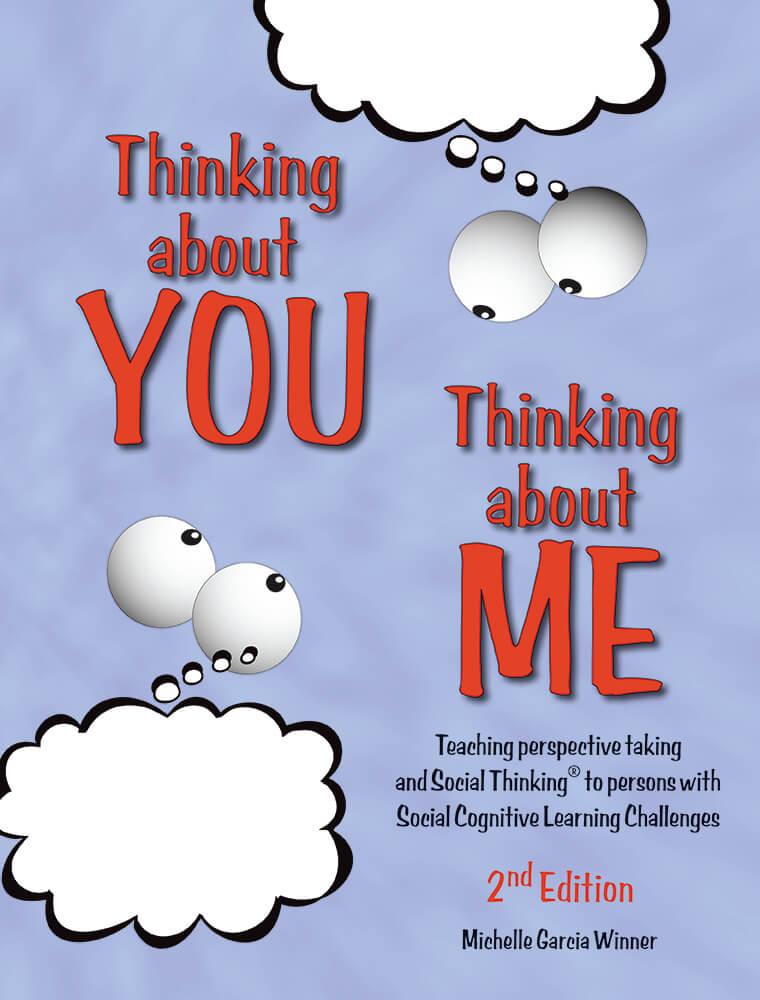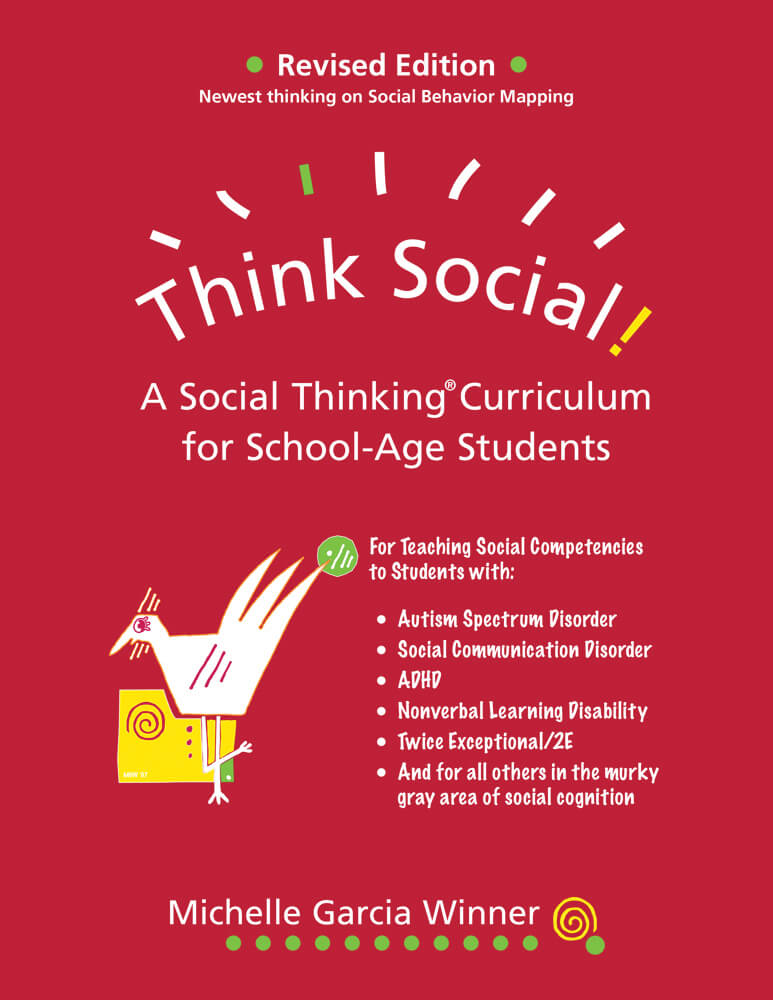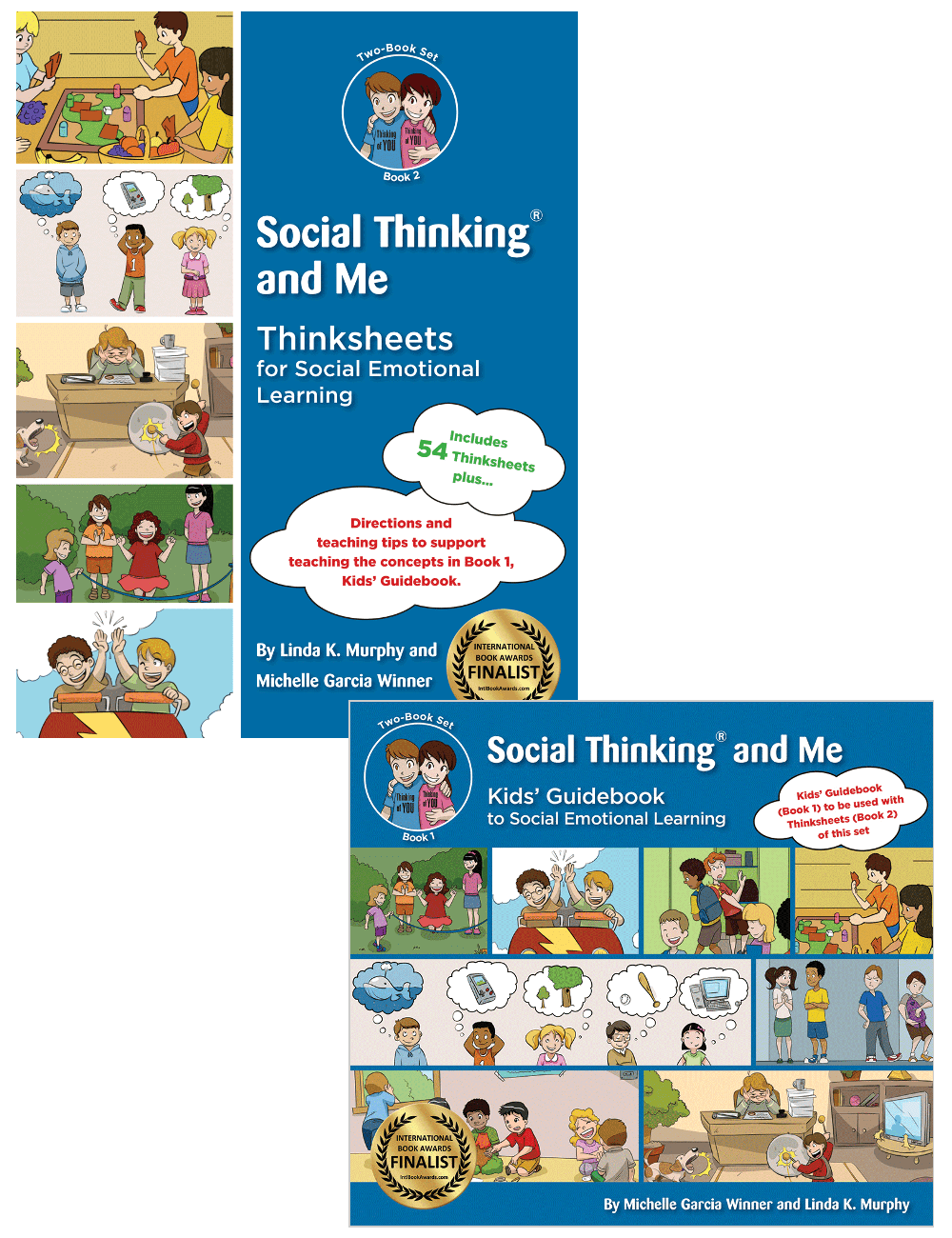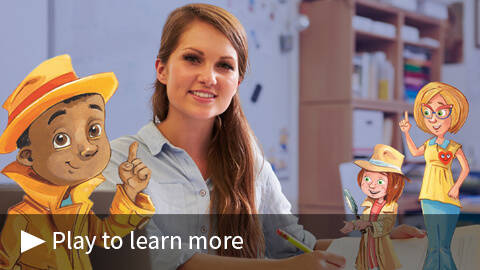Updated: May, 2022
© 2022 Think Social Publishing, Inc.
Click here to download a free infographic on The 5 Steps of Being with Others and explore additional resources on perspective taking.
Part 1- Social Perspective Taking: Our Meaning Maker
What is social perspective taking and when do we use it?
Social perspective taking occurs any time you share space with others, even in the absence of active social interactions. We use social perspective taking before, during, and after a social encounter to help us figure out our social responses, based on our own and others’ social goals in a situation. Now consider that most people think they only engage in social perspective taking during social interactions, such as when participating in a classroom, team sports, hanging out with friends, playing a game, or conversing face to face with another person. For example, if you notice shoppers move their shopping carts out of the way of fellow shoppers walking down the same aisle of a grocery store—that also requires using social perspective taking. If you see others waiting in line, you find your place at the end to wait your turn. Each of us, adapting our thoughts, movements, and what we say or do to consider others, requires the use of social perspective taking. In reality, social perspective taking is active any time anyone is thinking about others, even when these people are not physically present. For instance, we consider the actions, reactions, motives, and intentions of people in context within the novels and news stories we read and any time we watch people on our screens or listen to them on the radio or a podcast. Social perspective taking is expected to persist in the background of our thinking—if not the foreground—across the entire time we have others’ minds in our minds.
Why is social perspective taking important?
Consider what it would be like if humans did not have the capacity for social perspective taking. We would regard other people in much the same way as we would an object, such as a box of Kleenex, without thoughts, feelings, possible actions, and reactions. We don’t have to give much thought to walking by this box, since we don’t expect it to interpret us or our actions. Now consider that without some level of social perspective taking we would be unable to work well in groups, drive in traffic, play together, make friends, or engage in teamwork. Each of these activities requires us to consider our own and others’ perspectives as we share space, collaborate, or try to figure out others’ intentions. Social perspective taking helps us make meaning of people as they interact or coexist together in specific contexts; it also helps us to navigate to regulate in the social world—a world that expects us to be consciously aware of each other.
How to foster the development of social perspective taking
If the goal is to help individuals build their own social competencies when compared to their own baseline abilities, simply teaching a social skill (behavior) is not enough. We need to illuminate the usefulness of social perspective taking in their day-to-day lives. Unfortunately, interventionists tend to think about teaching social perspective taking when the behavior of a student is perceived as “doing something wrong.” Rather, we should teach them the power of their own social thoughts, feelings, and the expectations they have about others in their class, school, community, and at home. This provides them with the knowledge that they think and feel about what others are saying or doing (or not saying or doing); it’s not just that others have thoughts and feelings about their actions. As they learn about their own perspective, they can also start to learn that others have a different perspective and how to navigate through this social information.
Social perspective taking involves metacognition (i.e., thinking about thinking) because all participants or observers of a social situation typically think about what people are thinking and feeling, including their motives and intentions. We then use this thinking to interpret the situation and problem solve how to socially respond, which we refer to as developing social cognitive self-regulation. This means we navigate through a social situation and regulate what we do and say based on our own goals, as well as the expectations of others. A goal in treatment is to break down this information to teach different aspects of it in more detail, gradually fostering development of one’s social competencies.
Social perspective taking is developmental
Perspective taking is a developmental process, and concepts and skills related to social perspective taking become more complex with maturity. We all continue to learn about our own and others’ increasingly sophisticated perspectives across our lives. How we expect 5-year-olds to perceive and relate to each other’s perspectives is different from what we expect from 15-year-olds, which is different from what we expect of 25-year-olds, 45-year-olds, and 65-year-olds, etc.
Unpacking social perspective taking in five steps for social learners
The Social Thinking® Methodology includes a core treatment framework to teach about the perspective taking process. The 5 Steps of Being with Others is designed to be used by social learners—from ages 10 through adulthood—to help develop metacognitive awareness of the process through which we figure out how to respond socially, based on how we take perspective of each other’s thoughts, feelings, and intentions in context.
Part 2 - Social Perspective Taking: The 5 Steps of Being with Others
A framework to unpack social perspective taking in five steps
Social perspective taking is a complicated process that requires us to explicitly teach something that, for the neurotypical social learner, develops intuitively over time. Our role as interventionists is to help social learners begin to develop metacognitive awareness of different aspects of the many moving parts of perspective taking. The following five-step treatment framework seeks to define elements of this abstract process in a concrete manner that can be further explored and discussed.
Defining the 5 Steps of Being with Others
Step 1: I notice the social situation and the people in it. I am also aware that you are doing the same thing.
Step 2: In each social situation, I am aware that I am thinking about you and that you may be thinking about me.
Step 3: I think about why you and others are here, what each of you are thinking or feeling, what you are doing, and/or why you may be doing it. I am trying to figure out your motive, intention, or plan.
Step 4: I also realize you may be thinking about (or just noticing) me (and others in the situation), why each of us is in the social situation, what we each may be thinking, feeling, or planning, based on what I or others say or do to try and figure out our motives, intentions, or plans.
Step 5: I monitor and possibly adjust what I do or say to try to keep you thinking and feeling about my actions in the way I want you to, based on my own social goals for the situation and the expectations you have for me in this context. In the same way, you are likely monitoring and possibly adjusting what you do or say to try and keep me and others thinking and feeling about you in the manner you want, based on your social goals and our social expectations for each of us in this situation.
Considerations when using this teaching framework
These five steps happen within milliseconds and at an intuitive level below our immediate consciousness for most of us. The first four steps involve active social thought and metacognition; only the last step involves our seeking to adapt our behavior based on our collective social perspective taking and related social goals for this situation.
The 5 Steps of Being with Others is for use with tweens, teens, and adult social learners, as well as helpful for interventionists, to begin exploring this synergistic concept. These steps help individuals recognize and consider the extent to which we think about others and adjust our behavior based on our own and shared social goals within a situation, even in the absence of intentional social interaction.
Social perspective taking in the classroom
The 5 Steps of Being with Others treatment framework is an essential part of learning, working, and relating in a classroom. Embedded within most classroom environments or any situation where there is more than one person (in person or online) is a set of unspoken or hidden expectations (e.g., social norms). One hidden expectation within a classroom is that all participants are aware of the thoughts, feelings, and needs of the people present in that context and that all participants are expected to adapt their behavior to not only help themselves meet their own goal in that social situation, but also help others meet the collective goal(s). For example, Stephan needs help with a math problem; his goal is to get help from his teacher. He could accomplish this most efficiently by calling out “I need help!”, but that would disrupt the other students who are working on their math at this time. The collective goal of the class is to complete their individual math work assignments. Stephan recognizes yelling for the teacher would be “unexpected” for that particular situation (note: yelling can also be expected for another situation like playground play or in emergencies) and instead raises his hand as he looks toward the teacher.
As you review this example, consider that most parents and professionals assume that students automatically engage in this level of social cognitive self-regulation. Therefore, it’s not usually taught, even within most social emotional learning curricula. However, when students don’t know there are hidden expectations and then accidentally say or do something that is unexpected for that situation, they may be considered a “behavior problem.” Components of the Social Thinking® Methodology guide social learners—through treatment frameworks, Social Thinking Vocabulary, and strategies—toward increased understanding about dynamic perspective taking and how to notice it in specific social landscapes within the social world.
Considering Others
Our social brain is active even when we are aren’t hanging out or chatting with others. In fact, being around others requires our social system to ramp up to consider more than our own thoughts and feelings. As people share space together and/or interact, they do so with a basic assumption that we usually desire others around us to have reasonably "okay" or even “neutral” thoughts about what we say or do, even when our encounters are brief. Embedded in this assumption is the opposite: others want us to have "okay" or “neutral” thoughts and/or feelings about what they do or say. However, a challenge for those who struggle with some aspects of social learning is the process of perceiving and interpreting the thoughts and feelings of others as part of the social problem-solving process. It’s not uncommon for our clients to state that they say or do what they want because it makes sense and keeps them comfortable. They do this often without realizing that it may leave others feeling confused. For example, Madison, who interrupts a classmate’s explanation to make her own point in class, may feel her interruption makes sense because she has clarified the statement for the sake of accuracy. Yet, Madison may not understand that what she said left people confused or hurt.
Social evaluation, social judgment, and social memories: The social world has all three
Social judgment complicates the social world and it’s something we ALL do. We can’t help but make guesses and form social judgments about people’s intentions and people doing the same to us. Those who adapt what they do and say as a way to keep others having "okay" or “neutral” thoughts are much more likely to be considered friendly than when someone does or says something that creates "confused" social memories. In teaching social perspective taking, we help social learners first realize they have their own social judgements and memories about how what other people said or did made them feel (positive and negative). We teach that we all adapt what we do and say not only for what’s going in the present, but also based on how we hope people will remember our actions and reactions in the future. We routinely ask conference attendees why, when feeling frustrated in meetings or classrooms, they don’t just yell at others. The response is the same over and over, regardless of race, gender, age, or culture. Most of us don’t do or say whatever we feel in the moment because we know that others will have confused, or unpleasant social memories of the event and will likely recall that in future interactions.
Using a combination of social learning tools to teach more deeply
Social learners who struggle to understand the social world (some neurotypicals and Neurodivergents) work harder because they need to learn cognitively what many others know intuitively. On the other hand, some neurotypicals may not realize they instinctively and effortlessly engage in this level of metacognitive thinking. Helping neurotypicals understand how Neurodivergent see the social world can also help to establish empathy from both lenses. Appreciating these differences can help the interventionist slow down and take time to teach concepts more deeply to all types of learners.
Best practices: notice your own experience with the 5 Steps of Being with Others before teaching
Start by developing your own metacognitive awareness of the 5 Steps of Being with Others and spend part of the day paying attention to your own and others’ perceived thoughts and feelings, intentions, or plans and how this social information influences your actions and reactions in the presence of others. Your own experience can then be a guide as you explore these concepts with the tweens, teens, or adults with whom you work. Once you begin teaching, make sure to get ongoing feedback from your clients or students as to whether these 5 steps are helping in meeting their self-determined social goals.
Fostering social motivation within students to engage in this type of social learning
Believe it or not, most social learners are interested in learning about the metacognitive process—especially when the focus is on their perspective and their thoughts and feelings about others’ behaviors and intentions within a situation. Teaching through their perspective helps them realize they have a say in the social learning process which can help motivate them.
CAUTION: Never use the framework to point out an individual’s behaviors that might be perceived as problematic in the eyes of others. It’s not constructive, nor is it in keeping with our mission and intent. Instead, motivate social learners to think about social thinking concepts and learn how the social mind works. The Social Thinking Methodology focuses on breaking down complex social concepts to help build up individuals’ social competencies, step by step.
Next, explore the sister concept, 4 Steps of Face-to-Face Communication. Learn more about this concept and many others in the books Thinking About YOU Thinking About ME, 2nd Edition, Think Social! A Social Thinking Curriculum for School-Age Students, and Social Thinking Frameworks Collection.









